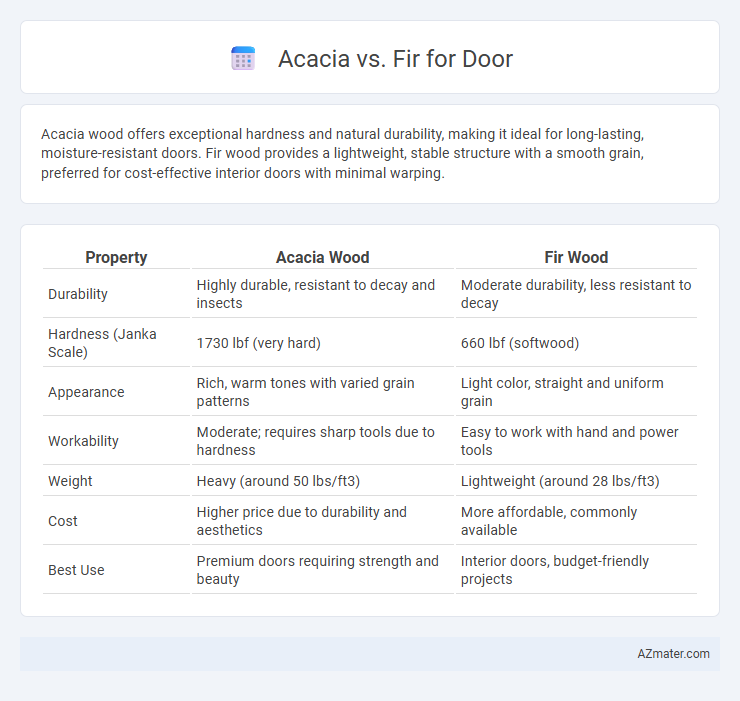Acacia wood offers exceptional hardness and natural durability, making it ideal for long-lasting, moisture-resistant doors. Fir wood provides a lightweight, stable structure with a smooth grain, preferred for cost-effective interior doors with minimal warping.
Table of Comparison
| Property | Acacia Wood | Fir Wood |
|---|---|---|
| Durability | Highly durable, resistant to decay and insects | Moderate durability, less resistant to decay |
| Hardness (Janka Scale) | 1730 lbf (very hard) | 660 lbf (softwood) |
| Appearance | Rich, warm tones with varied grain patterns | Light color, straight and uniform grain |
| Workability | Moderate; requires sharp tools due to hardness | Easy to work with hand and power tools |
| Weight | Heavy (around 50 lbs/ft3) | Lightweight (around 28 lbs/ft3) |
| Cost | Higher price due to durability and aesthetics | More affordable, commonly available |
| Best Use | Premium doors requiring strength and beauty | Interior doors, budget-friendly projects |
Introduction to Acacia and Fir Wood
Acacia wood, known for its rich, warm tones and natural durability, offers excellent resistance to moisture and pests, making it a popular choice for door construction. Fir wood features a lighter color with a straight grain pattern, prized for its strength and stability in both indoor and outdoor applications. Both woods provide distinct aesthetic and functional benefits, with Acacia favored for its exotic appearance and Fir valued for its structural reliability.
Key Characteristics of Acacia Wood
Acacia wood stands out for its exceptional hardness, rich natural grain, and superior durability, making it an excellent choice for door construction. Its high resistance to moisture and insects ensures long-lasting performance, while the warm, varied hues ranging from golden to reddish-brown enhance aesthetic appeal. Compared to fir, Acacia provides greater strength and requires less maintenance, ideal for both interior and exterior doors.
Key Characteristics of Fir Wood
Fir wood, commonly used in door construction, is known for its strength, stability, and straight grain patterns, which provide a smooth and clean finish. It has a light reddish-brown hue that darkens with age, offering a warm and natural aesthetic without excessive knots or imperfections. Fir's resistance to warping and moderate durability makes it ideal for interior doors, although it may require proper sealing to enhance moisture resistance.
Durability and Strength Comparison
Acacia wood exhibits exceptional durability and resistance to wear, making it highly suitable for door construction in high-traffic areas. Fir, while lighter and easier to work with, offers moderate strength but is less dense and more prone to dents and scratches over time. The superior hardness and natural oils in Acacia contribute to its enhanced longevity and robustness compared to Fir, ensuring doors remain sturdy and resilient under daily use.
Visual Appeal: Grain and Color Differences
Acacia wood showcases a rich, warm color palette with golden and reddish hues, highlighted by its distinctive, irregular grain patterns that create a rustic and luxurious appearance ideal for doors seeking a natural, eye-catching charm. Fir, in contrast, exhibits a lighter, more consistent tone with a straight, uniform grain that offers a clean and modern aesthetic, making it suitable for minimalist and contemporary door designs. The striking color variation and bold grain in Acacia provide a dramatic visual statement, while Fir's subtle grain and pale shades deliver a timeless, understated elegance.
Resistance to Moisture and Insects
Acacia wood exhibits superior resistance to moisture due to its dense grain and natural oils, making it ideal for doors exposed to humid environments. Fir, while commonly used for doors, is more prone to moisture absorption and less resistant to insect damage without additional treatment. The natural durability of Acacia against fungi and termites gives it an advantage over Fir in terms of longevity and maintenance requirements.
Sustainability and Environmental Impact
Acacia wood offers superior sustainability due to its rapid growth rate and efficient carbon sequestration compared to fir, which grows more slowly and requires longer rotation periods. Harvesting acacia contributes less to deforestation and biodiversity loss, making it a more eco-friendly option for door production. Fir, while widely available, often involves higher environmental costs related to habitat disruption and slower forest regeneration.
Cost and Availability Analysis
Acacia doors typically cost more than fir doors due to Acacia's dense hardwood quality and natural resistance to wear, making it a premium choice for durability. Fir doors are generally more affordable and widely available, sourced from fast-growing softwood species, which results in lower production costs and easier access in most markets. Availability of fir is higher in North America, while Acacia is more common in tropical regions, influencing regional pricing and supply chain factors.
Best Use Cases for Acacia and Fir Doors
Acacia doors are ideal for high-traffic areas due to their exceptional hardness and natural resistance to moisture and insects, making them perfect for exterior doors and bathroom entrances. Fir doors, valued for their straight grain and smooth finish, are best suited for interior doors, offering a cost-effective option with good strength and easy staining for decorative purposes. Both woods provide durability, but Acacia's dense grain excels in weather-exposed environments, while Fir is preferred for controlled indoor settings where aesthetic customization is desired.
Conclusion: Which Wood is Right for Your Door?
Acacia wood offers exceptional durability and rich, warm tones ideal for doors exposed to varying weather conditions, while fir provides a cost-effective, lightweight option with a consistent grain suited for interior doors. For exterior doors requiring superior hardness and resistance to moisture, acacia stands out as the optimal choice. Fir is preferable for budget-conscious projects or where a uniform appearance is desired without compromising basic performance.

Infographic: Acacia vs Fir for Door
 azmater.com
azmater.com